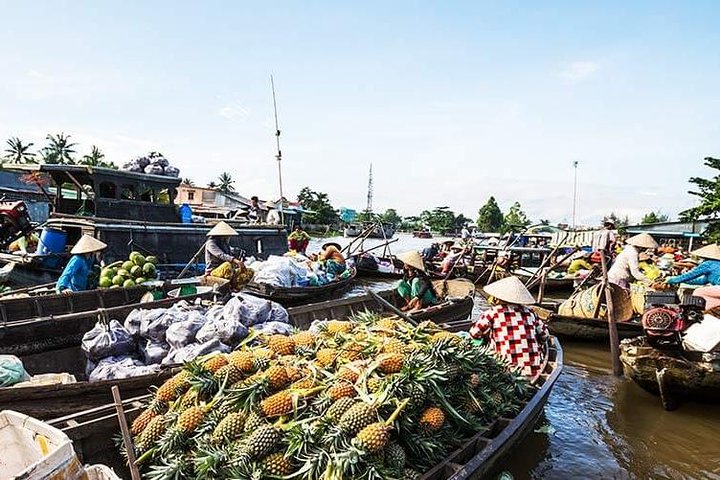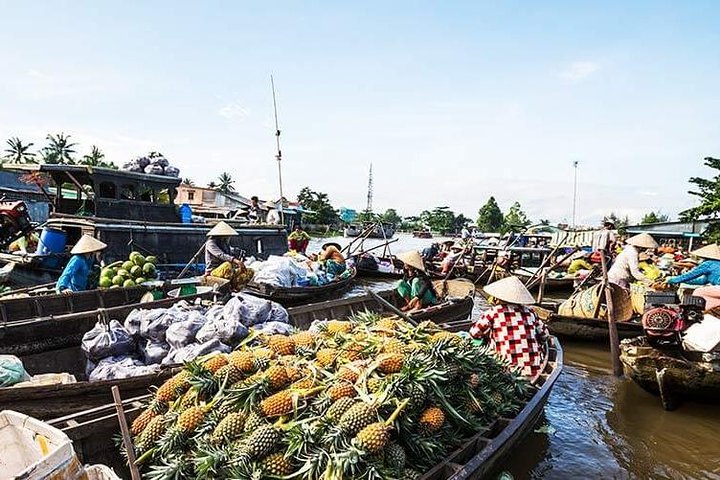Explore Saigon’s rich history and culture with a shore excursion from Saigon Port. Visit Cu Chi Tunnels, War Remnants Museum, and iconic landmarks.
Explore Saigon’s rich history and culture with a shore excursion from Saigon Port. Visit Cu Chi Tunnels, War Remnants Museum, and iconic landmarks.
- History Museum of Ho Chi Minh City - Established in 1929, this prominent Sino-French museum showcases a rich collection of artifacts that trace the cultural evolution of Vietnam, from the Bronze Age Dong Son civilization (dating back to 2000 BCE) and the Funan civilization (1st to 6th centuries CE) to the Cham, Khmer, and Vietnamese cultures….
- History Museum of Ho Chi Minh City - Established in 1929, this prominent Sino-French museum showcases a rich collection of artifacts that trace the cultural evolution of Vietnam, from the Bronze Age Dong Son civilization (dating back to 2000 BCE) and the Funan civilization (1st to 6th centuries CE) to the Cham, Khmer, and Vietnamese cultures. Highlights include precious relics from Cambodia’s Angkor Wat and an impressive array of Buddha statues. There is ample information available in English. Some sections of the museum are currently under renovation.
The museum also features a well-preserved mummy of a local woman who passed away in 1869, discovered in Xom Cai in District 5, as well as beautiful mother-of-pearl Chinese characters inlaid into panels. It is situated next to the Botanical Gardens.
The museum also covers the diverse cultures of ethnic groups in Southern Vietnam and other Asian countries. Visitors can explore their traditional clothing, unique musical instruments, deity statues, and tools used in agriculture, hunting, and fishing.
-
The Independence Palace - Encircled by royal palm trees, the striking 1960s architecture of this iconic government building and the eerie atmosphere of its empty halls make it a fascinating sight. The first Communist tanks to enter Saigon arrived here on April 30, 1975, and it feels as though time has stood still since that day. The building is closely linked to the fall of the city in 1975, but it is the kitschy details and period motifs that truly stand out. It is also referred to as the Independence Palace.
The building, named Independence Palace, served as the residence of the South Vietnamese president, Nguyen Van Thieu, until his abrupt departure in 1975. Designed by Paris-trained Vietnamese architect Ngo Viet Thu, it is a remarkable example of 1960s architecture, featuring a light and open design.
The Reunification Palace, also known as Independence Palace, is a significant landmark in the heart of Ho Chi Minh City and is considered a must-see national monument. - Emperor Jade Pagoda - Constructed in 1909 to honor the supreme Jade Emperor (King of Heaven), this is one of the most atmospheric temples in Ho Chi Minh City, filled with statues of mystical deities and heroic figures.
The air is thick with the scent of incense, partially obscuring the intricate woodcarvings. The roof is adorned with elaborate tile work, and the temple’s statues, representing characters from both Buddhist and Taoist traditions, are crafted from reinforced papier-mâché.
The temple’s multifaith nature is reflected in its alternative name, Phuoc Hai Tu, which conveys a Buddhist message. Similarly, the Chinese characters in the main hall mean ‘The light of Buddha shines on all.’
Over a century old, the Jade Emperor Pagoda retains its timeless charm. Its beauty is a harmonious blend of three major Eastern religions: Taoism, Buddhism, and Confucianism.
Thanks to its impressive and unique beauty, along with its sacred legends, this is one of the most remarkable destinations.
- Sơn mài Đại Việt - Lacquer is actually the resin of a tree, mixed with colored pigments and solvents, and applied in layers to an object’s surface, resulting in a shiny and durable finish. Eggshell and mother of pearl may be added to the surface before the lacquer is applied, and the finished product is then sanded to reveal the decoration beneath.
The high quality of resin from Vietnamese lacquer trees, especially those in Phu Tho, was a key factor in the rapid development of this art form during the feudal period.
Decorated lacquer statues, panels, boxes, and trays (1428-1527) can still be seen in many temples and pagodas.
In later centuries, the use of lacquerware expanded to larger items such as wooden chairs and tables.
Since then, lacquerware has continued to evolve into a cornerstone of the Vietnamese handicraft industry, both domestically and internationally. Today’s most popular items include vases, jewelry boxes, desk sets, trays, and vertical blinds.
- Museum of Ho Chi Minh City - A grand neoclassical building constructed in 1885, formerly known as Gia Long Palace, HCMC’s city museum is a uniquely beautiful and impressive structure that tells the story of the city through archaeological artifacts, ceramics, old city maps, and exhibits on the marriage traditions of its various ethnic groups. The struggle for independence is extensively documented, with most of the upper floor dedicated to it.
Beneath the building lies a network of reinforced concrete bunkers and fortified corridors. This system, with branches extending to the Reunification Palace, included living quarters, a kitchen, and a large meeting hall. In 1963, President Diem and his brother hid here before fleeing to Cha Tam Church. The network is not open to the public as most of the tunnels are flooded.
In the gardens, there are various pieces of military hardware, including the American-built F-5E jet used by a renegade South Vietnamese pilot to bomb the Reunification Palace on April 8, 1975.
- Central Post Office - This iconic French-era post office is a classic example of period architecture, designed by Marie-Alfred Foulhoux (though often attributed to Gustave Eiffel) and built between 1886 and 1891. A mosaic of Ho Chi Minh is prominently displayed at the end of its barrel-vaulted hall.
The post office features a distinctive bright yellow exterior with white trim. Curved windows are elegantly framed with green shutters, and a large clock is prominently displayed at the main entrance. The stunning, spacious interior boasts tall, domed ceilings with metal arches and a beautiful patterned tile floor. Inside, there are two painted maps – ‘Lignes télégraphiques du Sud Vietnam et du Cambodge 1892’ (Telegraphic lines of southern Vietnam and Cambodia 1892), depicting the postal route from southern Vietnam to Cambodia, and ‘Saigon et ses environs, 1892’ (Saigon and its surroundings), a local map.

- All entrance fees
- Bottled water
- Air-conditioned car/van
- English speaking tour guide
- Pick up & drop off at Saigon Port, No.05 Nguyen Tat Thanh street, District 4
- All entrance fees
- Bottled water
- Air-conditioned car/van
- English speaking tour guide
- Pick up & drop off at Saigon Port, No.05 Nguyen Tat Thanh street, District 4
- Tipping/ gratuities, personal expenses
- Extra charge $30 USD/ each will be collected on tour for picking up at Hiep Phuoc JSC/ SPTC Terminal
- Tipping/ gratuities, personal expenses
- Extra charge $30 USD/ each will be collected on tour for picking up at Hiep Phuoc JSC/ SPTC Terminal
Ho Chi Minh City, also known as Saigon and long considered as the Pearl of the Far East, is the most dizzying city of commerce and culture in Vietnam. A visit to Saigon is like an encounter with exotic delicious food, French colonial architecture and memories of Vietnam War. After picking up from Saigon Port or Hiep Phuoc JSC/ SPTC Terminal, you will be…
Ho Chi Minh City, also known as Saigon and long considered as the Pearl of the Far East, is the most dizzying city of commerce and culture in Vietnam. A visit to Saigon is like an encounter with exotic delicious food, French colonial architecture and memories of Vietnam War. After picking up from Saigon Port or Hiep Phuoc JSC/ SPTC Terminal, you will be driven to Cu Chi tunnels. On the way, you will have a chance to learn the works of handicap handicrafts factory—made largely from local materials which is running to support those handicaps who are victims from Vietnam War. You will discover Cu Chi Tunnels system afterward and then War Remnants Museum to learn more about Vietnam War. You will be also passed by former General commander William Childs Westmoreland’ house in Saigon before taking photo stop in city hall where you have a chance to take glimble of sightseeing the Rex Hotel which is used to be American Office during Vietnam War.
- The remaining hours are allotted for the travel time
- Everyone can join this tour
For a full refund, cancel at least 24 hours before the scheduled departure time.
For a full refund, cancel at least 24 hours before the scheduled departure time.
























